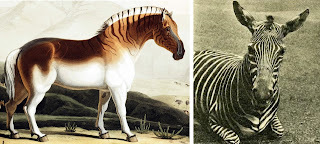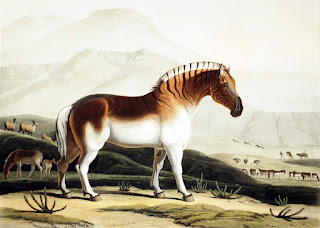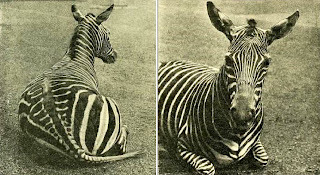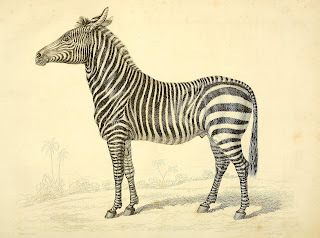DANIELL'S QUAGGA AND WARD'S ZEBRA - ANOTHER TWO STRIPED CURIOSITIES OF THE EQUINE KIND
 Daniell'squagga (left) and Ward's zebra (right) (public domain)
Daniell'squagga (left) and Ward's zebra (right) (public domain)
Following on from my previousShukerNature article concerning the beautiful but long-forgotten isabella quagga(click here to access it), here are another twoeyecatching but exceedingly obscure striped curiosities of the equine kind, retrievedfrom the annals of zoological history.
DANIELL'S QUAGGA – THE MOST EXTREME QUAGGA OF ALL?
Yes indeed,this particular quagga specimen is so extreme that it makes even the isabellaquagga seem positively commonplace by comparison!
Thespecimen in question is a truly remarkable beast known as Daniell's quagga,after the artist Samuel Daniell (1775-1811), who produced a very handsome aquatintof it in 1804 for his African Scenery andAnimals at the Cape of Good Hope two-part series (1804-1805). He based itupon this quagga form's only known specimen, which had been shot in southernAfrica's so-called Square Mountains (currently unidentified by me) during 1801,but whose skin was not retained.
 Daniell's quagga, painted by Samuel Daniell as itwould have looked when alive in 1801 (public domain)
Daniell's quagga, painted by Samuel Daniell as itwould have looked when alive in 1801 (public domain)
Whatwas so extraordinary about it, as readily seen in Daniell's painting, is thatthis quagga specimen had exceptionally reduced striping. Indeed, the lattermarkings were confined almost entirely to the sides of the animal's neck, withonly a few very faint lines upon its throat and shoulders, and none at all uponits torso. (True, I have seen paintings of certain other quagga specimens withstripeless torsos, but their throat and shoulders in addition to their neck allbore distinct, conspicuous stripes.) It also had a noticeably large head.
Aswith the isabella quagga, this specimen was initially deemed to represent a newzebra species, dubbed Daniell's quagga, and was accordingly given the speciesname danielli. However, and onceagain like its isabelline relative, Daniell's quagga was later subsumed intothe plains zebra species Equus quaggaas merely a non-taxonomic freak individual.
WARD'S ZEBRA – A ZEBRA CROSSING IN EVERY SENSE!
Ward'szebra is a distinctively-striped, long-eared interspecific hybrid resulting frommatings between plains zebras E. quaggaand mountain zebras E. zebra that wasfirst brought to scientific attention in 1904 via a Proceedings of the Zoological Society of London report by Britishzoologist Prof. J.C. Ewart. In his report, Ewart stated that some yearspreviously he had been presented with a taxiderm zebra specimen, the subject ofhis report, by Rowland Ward, who was a very famous London-based taxidermist atthat time. Ewart had subsequently donated it to Edinburgh's Royal ScottishMuseum (now part of the National Museum of Scotland).
Accordingto Ward, the specimen had originally been "traded out of Somaliland",Somaliland nowadays being recognized as a region within Somalia. However, Ewartspeculated that its kind "probably inhabits part of the area between theupper reaches of the Tana River and Lake Rudolf [later renamed LakeTurkana]", in Kenya.
 Ward's zebra - two views of Ewart's erstwhile taxidermhybrid specimen, from his 1904 PZSLreport (public domain)
Ward's zebra - two views of Ewart's erstwhile taxidermhybrid specimen, from his 1904 PZSLreport (public domain)
Ewartwas struck by the specimen's overall similarities to South Africa's Cape mountainzebra (E. z. zebra; Hartmann'smountain zebra E. z. hartmannaeoccurs in Namibia and Angola), but also noting in detail various differences inits striping, as well as its very long ears. Clearly not suspecting its hybridnature, Ewart concluded his report by suggesting that it may constitute a new formof Kenyan plains zebra, duly dubbing it Ward's zebra in honour of itsprocurer, which "is adapted to a habitat similar to that of the mountainzebra", i.e. an example of convergent evolution.
In1910, moreover, Ward's zebra was formally named Equus wardi, but its hybrid status was revealed via the discoverythat specimens of this zebra form had been obtained repeatedly in the Jardindes Plantes, Paris, around 1900. And in 1915, a male specimen was obtained atLondon Zoo. Indeed, some authorities have opined that Ewart's specimen haditself probably been bred in a menagerie, rather than originating from either thewilds of Somaliland or of Kenya.
 Vintageengraving of the Cape mountain zebra, 1830 (public domain)
Vintageengraving of the Cape mountain zebra, 1830 (public domain)
Karl Shuker's Blog
- Karl Shuker's profile
- 45 followers



